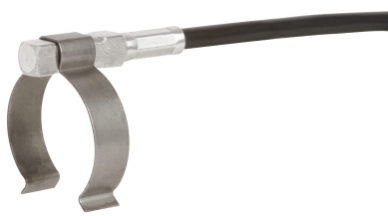
Temperature is by far the most common measurand in the industry. However, there are no general solutions for temperature measurement. Even when designing measuring points on pipelines, many different factors for selecting thermometers must be taken into account. The following aspects are crucial for deciding whether a screw-in thermometer (invasive method of measurement) or a strap-on thermometer (non-invasive method of measurement) should be used.
Response time and accuracy
The big advantage of screw-in thermometers is obvious: They are in contact with the medium. This is why screw-in thermometers are used for all those applications in which, besides accuracy, short response times are extremely important, e.g. in the production processes of the process industry. In these applications, measuring instruments are mostly integrated in control and regulation systems.
For temperature measurement in machine building or comparable applications, thermometers usually have only a monitoring function. The accuracy requirements are therefore lower than in chemical or pharmaceutical processes. The response time is rarely critical. Therefore, strap-on thermometers represent an effective solution in these cases. Their heat absorption depends crucially on the size, material and geometry of the case. Aluminium versions have a shorter warm-up time than those made of stainless steel or brass. Airspaces in the measuring point, e.g. in an insert sleeve for the thermometer, can additionally reduce the heat transfer. This effect can be partially compensated by means of a special thermal compound.
Process temperature
The process temperature limits for strap-on thermometers are clearly defined. They are suitable for maximum temperatures up to 200 °C. The heated pipeline would otherwise melt the insulation of the connection lead. Screw-in thermometers, on the other hand, can be used up to approx. 400 °C, depending on the version.
Ambient temperature
When using a strap-on thermometer, the influence of the ambient temperature on the temperature measurement is generally greater than with a screw-in thermometer. In such cases, in order to obtain usable results, the measuring point must be well insulated, especially in applications where a large temperature difference between the medium and the environment occurs. The smaller the probe case, the more likely prefabricated insulating components can be used. If the insertion length is too small, the error caused by heat dissipation can also be great when using a screw-in thermometer. Therefore, strap-on probes are better suited for small pipe diameters, assuming good insulation.
Influence of the thermometers on the medium
Strap-on thermometers don’t come in contact with the medium during measurement and therefore do not affect the medium in any way. On the other hand, screw-in thermometers can obstruct the medium flow in pipes with small nominal widths. Furthermore, deposits on the stem cannot be ruled out, which can affect both the measuring result and the quality of the medium in extreme cases.
Installing and operating the measuring point
To install a screw-in thermometer, the pipeline must be opened and a mounting socket for the thermometer attached. The measuring instrument must be designed in such a way that it is application-specific, not only in terms of accuracy and response time. If aggressive media are used, it may require a stem made of special material or an additional thermowell. To calibrate or replace the thermometer, the line must first be drained (except for measuring points with thermowell).

Figure 1: Strap-on thermometer mounted on the pipeline
When using strap-on thermometers, the pipeline always remains closed. There is no need to take account of aggressive media and therefore of the suitable materials for the thermometer. Due to the comparatively flat shape of the measuring point, installation can also be performed in tight spaces.
A strap-on thermometer is attached to the pipeline using a pipe clamp or a tightening strap. The sensor housing usually has a rounded contact surface adapted to the respective pipeline diameter. Applications with different pipeline diameters require different instrument versions in this case.

Figure 2: Strap-on thermometer with quick-mounting bracket
Against this background, WIKA has designed the model TF44 strap-on thermometer. Its aluminium case features excellent thermal conductivity and, with an edge length of just six millimetres, is ideally suited for all nominal widths.
Compared to the installation of screw-in thermometers, strap-on thermometers are less costly in terms of material and manual work. However, the increasingly tighter installation situations, whether in a heat pump or a combined heat and power plant, make the necessary manual operations more complicated.

Figure 3: Quick-mounting bracket for strap-on thermometer TF44
This aspect was taken into account when developing the TF44. Installation in tight spaces is tool-free and can be done using quick-mounting brackets. They are available for pipe diameters between 12 and 42 millimetres.
Do strap-on thermometers have an advantage in case of small nominal widths?
In the process industry, the invasive method for temperature measurement in pipelines is still recommended. However, the continuing trend toward miniaturization makes it necessary to use compact strap-on thermometers in pipeline systems, especially in machine building and plant construction. Thanks to specially adapted systems of sensor, case and mounting brackets, the costs and effort for installing the measuring point can be reduced to a minimum.
What is your experience with measuring points on pipelines? Are strap-on thermometers the right choice or do you prefer the invasive measurement method? Is the trend toward miniaturization continuing in machine building or is the end in sight? Simply use the comment function and let us know what you think.
Note
Further information on the TF44 strap-on thermometer can be found on the WIKA website.


Thanks for writing such a good information.